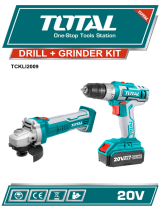
4
Additional safety warnings
Grinding, sanding, wire brushing, polishing or abrasion cutting operations
This power tool is designed to function as a grinder, sander, wire brush planer, polisher,
or cutting tool.
Read all safety warnings, instructions, illustrations, and specifications provided with this
power tool. Failure to follow all instructions can cause electric shock, fire, and / or serious
injury.
• Do not use this tool in operations for which it was not designed. Failure to do so
may create a hazard and cause personal injury.
• Do not use accessories and tools or tools that are not specifically designed and
recommended by the tool manufacturer. The fact that the accessory can be
connected to the power tool does not guarantee safe operation.
• The nominal speed of the blade must be at least equal to the maximum speed
marked on the power tool. A tool that has a speed greater than that of the tool
can eject it from its grip.
• The outside diameter and thickness of the disc must be within the nominal
capacity of its guards. Incorrectly sized accessories cannot be properly stored or
controlled.
• The assembly of threaded tools must match the thread of the grinder spindle. For
flange-mounted accessories, the hole in the accessory must match the flange
setting diameter.
• Do not use the damaged cutting tool. Before each use, check the cut-off wheels
for cracks, tears or excessive wear; check the wire brush for loose or cracked
wires. Dull bits cause the tool to be overstressed. If the power tool is dropped,
inspect for damage and replace if necessary.
After inspecting and installing a tool, move to a safe area and verify that there are
no people in the work area when operating the power tool at full speed with no
load for one minute. Damaged accessories will normally break during this testing
time.
• Wear personal protective equipment. Wear face shield, safety glasses. If
necessary, dust masks, ear protectors, gloves and workshop apron capable of
stopping small abrasive or chip fragments. Eye protection must be able to stop
debris and flying particles generated by various operations. The dust mask or
respirator must be able to filter the particles generated by its operation. Prolonged
exposure to high intensity noise can cause hearing loss.
• Keep people out of the work area. Anyone entering the work area must wear
personal protective equipment. Fragments of the workpiece or a broken
accessory can come loose and cause injury beyond the immediate area of
operation.
• Only hold the power tool by insulated gripping surfaces when performing an
operation where the cutting tool or tool may come into contact with cables and /
or pipes (including its own cable). It may cause an accident or electric shock to
the operator.
• Place the tool cord away from the swivel fixture. If you lose control, the cable can
be cut or snagged causing serious accidents.
• Never let go of the power tool until the cutting tool has come to a complete stop.
• Do not operate the power tool while it is with you. Accidental contact with the disc
could snag your clothing, pulling it closer to your body.
















